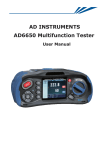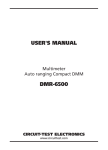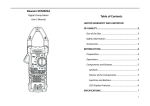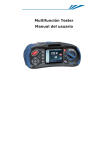Download Contents - testpower.se
Transcript
APS-9301 & APS-9501 & APS-9102 User’s Manual APS-9301 & APS-9501 & APS-9102 User’s Manual Contents 1. 2. 3. 4. 5. 6. 7 8. 9. 9.1 9.2 Safety terms and symbols……………………….………. Installation………………………….……………………….. Operation…………………………………………………….. Panel Description………………………………………….. Calibration …………………………………………….….. Circuit Principle…………………………………………… Block Diagram……………………………………………... Specification………………………………………………… Maintenance………………………………………………… 1 2 4 8 11 14 15 16 18 Cleaning…………………………………………………….. 18 Troubleshooting…………………………………………… 18 1. SAFETY TERMS AND SYMBOLS These terms may appear in this manual or on the product: WARNING:Warning statements identify condition or practices that could result in injury or loss of life. Caution:Caution statements identify conditions or practices that could result in damage to this product or other property. The following symbol may appear in this manual or on the product: Attention refer to Manual. 1 APS-9301 & APS-9501 & APS-9102 User’s Manual 2. APS-9301 & APS-9501 & APS-9102 User’s Manual 5.The size of input wire and output wire. Installation 1.Before installation, please make sure the AC input voltage is correct. a.The AC input voltage of APS-9301/9501 is either 115V or 230V, which can be selected. The select switch is located on the rear panel. Model APS-9301/9501 APS-9102 Input Wire Size 115V 230V AWG#14 0.75mm2 AWG#12 Output Wire Size AWG#18 2* AWG#18 6.An AC power cord is packaged in the unit of APS-9301/9501 as accessory. sel ect swi t ch V 0 3 2 7.The Selection of Output Test Lead: b. The AC input voltage of APS-9102 is fixed either at 115V or 230V, For safety reason,Do not make any change by you own to avoid damaging the instrument. 2.Before plugs input power cord to the suitable outlet or connects the input wires, please make sure all the APS-9301/9501/9102’s breakers are turned off. It will avoid the unnecessary accident or damage to APS-9301/9501/9102. 3.Plugs the input power cord to the suitable outlet or connects the input wires/cable to the input terminal block which is located inside panel of APS-9301/9501/9102. Please make sure the connections are very tight which may avoid some problem happening. 4.Please make sure the input tolerance of this APS-9301/9501/9102 is within ±15% of rated voltage (see figure 1) Max Output Voltage For safety assurance, please select the lead according to the following list: UL Conductor (CSA) Wire Component Cross Outer Model No. pc/mm Section Diameter Area AWG mm 2 (mm) 24 22 20 18 16 14 12 10 1015 TEW (Twisted Wire) 11/0.16 17/0.16 21/0.18 34/0.18 26/0.254 41/0.254 65/0.254 65/0.32 0.22 0.34 0.53 0.87 1.32 2.08 3.29 5.23 0.64 0.78 0.95 1.21 1.53 2.03 2.35 3.00 adequate output test Maximum Conductive Resistor Ω/km 88.6 62.5 39.5 24.4 15.6 9.90 6.24 3.90 Permissible Current A(amp) 7.64 10.0 13.1 17.2 22.6 30.4 40.6 55.3 Remark: 1. 150/300 120/240 120/240 2. 100/200 3. 100 85 90 95 115 The ambient temperature of “Permissible Current” is at 40℃, the withstanding temperature of conductor is at 105℃ according to the condition of the distributed single wire. The permissible current listed as above is suggested to be used under 70%. When the current value exceeds above suggestive list, can select more wires used in parallel according to above list. % of Rate Input Voltage Figure 1. 2 3 APS-9301 & APS-9501 & APS-9102 User’s Manual APS-9301 & APS-9501 & APS-9102 User’s Manual h. If any key mentioned above is not pressed for 2 seconds continuously, APS-9301/9501/9102 would go back to the normal operation and the voltage display could show the reading value automatically. 3. Operation 1.Voltage Setting: Voltage setting contents ‘110V ’, “ 220V ’, ‘▲’ and ‘▼’ four keys. a. When any one of the keys mentioned above is pressed, the voltage display will flash one time, the APS9301/9501/9102 will go to the setting mode and show the voltage setting value. b. If the ‘110V’ Key is pressed, the output voltage will be adjusted to 110V immediately. Meanwhile, the voltage display will switch back to the reading mode automatically. c. If the ‘220V’ key is pressed for 0.2 seconds continuously ( for safety reason, must be), the output voltage will be adjusted to 220V. Meanwhile, the voltage display will switch back to the reading mode automatically. Note: It would not work if the output voltage is setting on low range. (0~150V output) d. If either “▲” or “▼”key is pressed for 0.5 seconds continuously, the output voltage will be adjusted. If either “▲” or “▼” is pressed twice continuously, the output voltage will be adjusted immediately. e. The adjusting rates are 0.1V/step on fine adjust mode and 1V/step on coarse adjust mode. f. The first six steps of adjustment will be spent 0.25 seconds per step. If the key “▲” or “▼” is pressed continuously, it will spend 0.13 second per step for the rest steps. If the key is released, the voltage adjustment would be stopped and go back to the original adjustment speed (0.25 seconds per step) automatically. g. If the output mode is setting ON ( the indicator ‘OUTPUT’ would light), the output voltage could follow the setting voltage simultaneously Caution: When you adjust the voltage at “▲” or “▼” mode, it is better to switch off the output to avoid unnecessary damage because of accidental voltage adjustment. 4 2.Frequency Setting: Frequency setting contents ‘50Hz’, ‘60Hz’, ‘▲’ and ‘▼’ four keys. a. Either the key ‘50Hz’ or the key ‘60Hz’ is pressed, the frequency will be changed immediately to 50Hz, 60Hz respectively. Meanwhile the output frequency will be changed coincidentally. b. The frequency ranges from 45Hz to 99.9Hz can be adjusted by 0.1 Hz per step in fine adjustment mode and 1 Hz per step in coarse adjustment mode. The frequency ranges from 100Hz to 500Hz can be adjusted by 1 Hz per step in fine adjustment and 10Hz per second in coarse adjustment mode. c. The other setting are same as voltage setting. 3.High / Low Voltage range selection: Press the key of ‘RANGE’, if the indicator lights, the output voltage would be setting on the high voltage range, otherwise, the system would be setting on low voltage range. The changed range would not cause the setting voltage to change, however, there is a 20ms interruption during the voltage range changing. The non-reasonable range changing (For example, the voltage sets 200V but the range is changed to the low range) is not acceptable by APS-9301/9501/9102. Note: High range voltage 0 ~ 300V Low range voltage 0 ~ 150V 4.Instrumentation selection: a. Press the key of ‘A’, the indicator of current will light and the LED display will show the value of current. b. Press the key of ‘W’, the indicator of power will light and the LED display will show the value of wattage. c. Press the key of ‘PF’, the indicator of power factor will light and the LED display will show the value of power factor. 5 APS-9301 & APS-9501 & APS-9102 User’s Manual APS-9301 & APS-9501 & APS-9102 User’s Manual 5.Output Enabled and Disabled Operation: Press the key of ‘OUTPUT’. If the indicator of output lights, the output of APS-9301/9501/9102 is enabled, all the LED display will show the output value (reading value). Otherwise, the output function is disabled, and the LED display will show the setting value. Press the ‘OUTPUT’ key again to change the mode. 6.Lock Function: Press the key of ‘LOCK’. If the indicator of lock lights, all the keys are Locked (except the alarm reset). This function is good for avoiding any mistakes of key pressed during operation. Press again to change the mode. 7.Alarm Reset: If there is over current happened, APS-9301/9501/9102 would be shut down and buzz immediately. You must press the key of ‘ALARM RESET’ to clear the fault of over current and stop the buzz. In addition, the key of ‘OUTPUT’ have to be pressed to get the normal output voltage again. 8.Memory Function: As APS-9301/9501/9102 is equipped with EEPROM, the latest setting will be memorized after the unit is turned off. If the APS-9301/9501/9102 is turned on again, the latest setting will be displayed. 9.Save/Recall Function: Press the key of ‘S/R’, if the indicator of SAVE/RECALL doesn’t light, Press any one of keys ‘MEM1’ ‘MEM2’ ‘MEM3’ and ‘MEM4’ for 0.2 seconds, the current output setting will be saved. If the indicator of SAVE/RECALL lights, press any one of keys ‘MEM1’ ‘MEM2’ ‘MEM3’ and ‘MEM4’ for 0.2 seconds, the setting saved last time via the same key will be recalled as current settin 6 7 APS-9301 & APS-9501 & APS-9102 User’s Manual APS-9301 & APS-9501 & APS-9102 User’s Manual 4. Panel Description (12)Output Voltage LED Display If the ‘OUTPUT’ Key is not pressed, the indicator doesn’t light, and the setting value will be displayed on the Output Voltage LED Display. If the ‘OUTPUT’ key is pressed, the indicator lights, and the output value will be displayed on the Output Voltage LED Display. (1) ‘ALARM RESET’ Key Reset key to cease the buzz and reset the output. (2) ‘S/R’ Key Save or Recall function selecting key. (3) SAVE/RECALL indicator In the mode to save setting, the indicator doesn’t light. In the mode to recall setting, the indicator lights. (4) .(5) .(21). (22) ‘MEM1’ ‘MEM2’ ‘MEM3’ ‘MEM4’ keys When the SAVE/RECALL indicator is off, the four keys are for saving four different settings. When the indicator are on, the keys are for recalling the saved settings. (6).(23) ‘50Hz’、‘60Hz’Keys One touch key for 50Hz and 60Hz output respectively. (7) Output Frequency LED Display: If the ‘OUTPUT’ key isn’t pressed, the indicator doesn’t light, and the setting frequency value will be displayed on the output frequency LED display. If the ‘OUTPUT’ key is pressed, the indicator light, and the output frequency value will be displayed on the output frequency LED display. (8).(24). ‘▲’ 、‘▼’ Keys The two keys are for frequency setting, to increase or decrease the frequency value respectively every time they are pressed. The adjusting rate depends on the ‘COARSE’ key and the frequency value itself. (9) Coarse Indicator If the coarse adjustment mode is selected, the coarse indicator will light. If the fine adjustment mode is selected, the coarse indicator does not light. (10)High / Low Range Indicator of Output Voltage If this indicator lights, the output voltage is in the range 0 ~ 300V. If this Indicator does not light, the output voltage is in the range 0 ~ 150V. (11).(27). ‘ 110V ’, ‘ 220V ’ Keys One touch key for 220V and 110V output respectively. 8 (13).(28). ‘▲’、‘▼’ keys The two keys are for voltage setting, to increase or decrease the voltage value respectively every time they are pressed. The adjusting rate depends on the ‘COARSE’ key. (14)Function of Ammeter Indicator If ammeter’s indicator lights, the value of output current will be displayed On the multimeter LED display. (15)Function of Wattage Meter Indicator If wattage meter’s indicator lights, the value of output wattage will be displayed on the multimeter LED display. (16) Multimeter LED Display The value of output current, wattage or power factor will be displayed by respective key from ‘A’, ‘W’, to ‘PF’. (17) Function of Power Factor Meter Indicator If power factor meter’s indicator lights, the value of output power factor will be displayed on the multimeter LED display. (18) ‘OUTPUT’ Key Output function enabled/disabled selection key. (19)Output Indicator When output is enabled, the output indicator will light. (20)Power Switch To turn on /off APS9301/9501. (25) ‘ COARSE ’Key Coarse/Fine adjustment selection key. (26) ‘ RANGE ’ Key For the high / low output voltage’s range selection. 9 APS-9301 & APS-9501 & APS-9102 User’s Manual APS-9301 & APS-9501 & APS-9102 User’s Manual (29) ‘A ’Key Ammeter selection key of multimeter LED display 5. Calibration (30) ‘W ’ Key Wattage meter selection key of multimeter LED display. (31) ‘PF’ Key Power factor meter selection key of multimeter LED display. (32) ‘LOCK’ Key Lock / Unlock keyboard selection key. (33)Lock Indicator The lock indicator lights to indicate the keyboard is locked. All other keys Except ‘RESET’ are disabled. (34)Outlet Output socket Caution: The maximum AC voltage is up to 300V. Do not touch the output sockets when the OUTPUT indicator appears lit. The calibration of APS-9301/9501/9102 has been done in the factory. If it is necessary to do the calibration again, the procedures can be followed as: 1.Check if the APS-9301/9501/9102 works normally. Then turn off the APS-9301/9501/9102. 2.Press the ‘LOCK’ key continuously meanwhile turn on the APS9301/9501. The key of ‘LOCK’ must be pressed for 2 seconds at least until the LED Display steady. Then APS-9301/9501/9102 is in the calibration mode. 3. Selection of APS-9301,APS-9501 and APS-9102 Use the ‘▲’ key of frequency to choose the correct mode of APS series. The numbers are as following: 00: means APS-9301 01: means APS-9501 02: means APS-9102 4. Voltmeter Calibration a. Press the ‘PF’ key , the APS-9301/9501/9102 will offset the voltmeter and provide a approximate 240V’s output voltage. b. Connect a standard true RMS voltmeter to the output socket of APS9301/9501/9102 c. Use the key ‘ ▲ ’ and ‘ ▼ ’ of voltage to adjust the APS9301/9501/9102’s output voltage till to 240V exactly. d. Press the key ‘LOCK’, the calibration is completed. 5.Ammeter Calibration There are low and high ranges calibration for ammeter A. Low range calibration 1) Make sure the Coarse indicator is extinguished. If the coarse indicator appears lit, press ‘COARSE’ key to put out the indicator. 2) Press the key ‘A’, APS-9301/9501/9102 will offset the low range of ammeter and provide a 110V’s output voltage automatically. 10 11 APS-9301 & APS-9501 & APS-9102 User’s Manual APS-9301 & APS-9501 & APS-9102 User’s Manual 3) Connect a standard true RMS ammeter and variable resistor to the output socket of APS-9301/9501/9102. Note: The closer the voltage sensing point of wattage meter is to the Output socket, the better. 4) Adjust the APS-9301/9501/9102’s output voltage or the variable resistor till to get 1.8A exactly seen from the true RMS ammeter. 4) Adjust the APS-9301/9501/9102’s output voltage or the variable resistor till to get 300W seen from standard RMS wattage meter exactly. 5) Press the key ‘LOCK’, the calibration of the low range of ammeter of APS-9301/9501/9102 is completed. 5) Press the key ‘LOCK’, the calibration of the low range of wattage meter of APS-9301/9501/9102 is completed. B. High range calibration B. High range calibration 1) Make sure the Coarse indicator appear lit. If not, press the key ‘COARSE’ to turn on the indicator. 1) Make sure the coarse indicator appear lit. If not, press the key ‘COARSE’ to turn on the indicator. 2) Press the key ‘A’, APS-9301/9501/9102 will offset the high range of ammeter and provide a 110V’s output voltage automatically. 2) Press the key ‘W’, APS-9301/9501/9102 will offset the high range of wattage meter and provide a 110V’s output voltage automatically. 3) Connect a standard true RMS ammeter or a variable resistor to the output socket of APS-9301/9501/9102. 3) Connect a standard true RMS wattage meter and a variable resistor to the output socket of APS-9301/9501/9102. Note: The closer the voltage sensing point of wattage meter is to the Output socket, the better. 4) Adjust the APS-9301/9501/9102’s output voltage or the variable resistor till to get 2.5A(9301) /4A(9501) /8.0A(9102) seen from the true RMS ammeter. 5) Press the key ‘LOCK’, the calibration of the high range of ammeter of APS-9301/9501/9102 is completed. 4) Adjust the APS-9301/9501/9102’s output voltage or the variable resistor till to get 300W(9301) / 450W(9501) /900W(9102) seen from the standard RMS wattage meter exactly. 5) Press the key ‘LOCK’, the calibration of the high range of wattage meter of APS-9301/9501/9102 is completed. 6. Wattage Meter Calibration There are low and high ranges calibration for wattage meter A. Low range calibration 7. Turn off the input circuit breaker of APS-9301/9501/9102 after the calibration is completed. Then turn on the input circuit breaker again, the APS-9301/9501/9102 will operate normally. 1) Make sure the Coarse indicator is extinguished, if not, press key ‘COARSE’ to put out the indicator. 8. Each function of calibration is independent. If only one or two items need to be calibrated, it is not necessary to calibrate all the items. 2) Press the key ‘W’, APS-9301/9501/9102 will offset the low range of wattage meter and provide a 240V’s output voltage automatically. 9. If the calibration have to be interrupted during the calibration procedure, you can press the key of ‘PF’, ‘A’, or ‘W’ of the voltmeter, ammeter, or wattage meter respectively to stop the calibration. 3) Connect a standard true RMS wattage meter and a variable resistor to the output socket of APS9301/9501/9102. 12 10. If the calibration can not be processed, please call for service. 13 APS-9301 & APS-9501 & APS-9102 User’s Manual APS-9301 & APS-9501 & APS-9102 User’s Manual 6. Circuit Principle 7. Block Diagram The APS series products are controlled by CPU and operated via keyboard. The APS series are fully digital controlled. I/P Keyboard The input isolate transformer has bee applied to isolate the city power from the APS series. And step down the input voltage for appropriate applications. The main AC power is rectified and filtered to become a very smooth DC source for power amplifier. Sine ware form is generated by the digital synthesizer and filtered by a very high impedance filter. Therefore, the sine ware form will be very stable and the distortion will be reduced. For easy operation, the APS series equips a memory of EEPROM. The EEPROM will memorize the latest settings data automatically after the APS Series have been switched off. If the APS series is switched on again, the CPU could read all the data from the EEPROM and provide the output value same as the previous setting. It is unnecessary to reset the data after APS series are switched off. Power Amplifier Voltage Control Sine wave Synthesizer C Frequency Control Output Transformer P U Frequency Sensor Current & Voltage Feedback Memory A/D 14 Rect. / Filter Display The APS series have two voltage feedback systems. One is analog feedback system for quick response(within 100us), and the regulation will be located In the range of ±5%. The other is digital feedback system. The system will read the output voltage and compare with the settings. The accuracy of Output voltage will be limited in the range of ±0.1V. The sine wave signal is amplified by power amplifier. The power amplifier provides a very clean and low distortion sine ware to the output of APS series through the output transformer. The offset and calibration data of instrumentation are stored in the EEPROM. The instrumentation would be Calibrated automatically when the APS series is switched on. True RMS circuit is applied for the voltmeter and ammeter. The value of LED display is true RMS value. Isolated Transformer Current & Voltage Sensor 15 O/P APS-9301 & APS-9501 & APS-9102 User’s Manual APS-9301 & APS-9501 & APS-9102 User’s Manual 8. Specifications Digital Display: This section contains a table of APS-9301/9501/9102 characteristics. Frequency Counter Table 1: Specification RMS Voltmeter Specification Description Output Frequency (45.0~500Hz) Digital setting via keys, Resolution: 0.1Hz Accuracy: ±0.1Hz RMS Ammeter Output Voltage (AC0.0 ~ 300.0V) Digital setting via keys, Resolution: 0.1Vrms Accuracy: ±0.1%rdg+1digit Wattage Meter Output Capacity Low voltage range: 0.0 ~ 150Vac High voltage range: 0.0 ~ 300Vac Output Power 300VA(9301); 500VA(9501); 1KVA(9102) Maximum Current APS-9301: 2.6A(0~150V), 1.3A(0~300V) APS-9501: 4.2A(0~150V), 2.1A(0~300V) APS-9102: 8.4A(0~150V), 4.2A(0~300V) Line Voltage Regulation Load Regulation Protection Frequency Stability Power Factor Meter Line Input Requirement Calibration AC Power consumption Operation Environment ±0.1% ±(0.5%+0.1V) Accessory Key Lock, OCP, Short Circuit Protect,OTP Dimensions Weight ≦100PPM Measuring Range:0.0~999Hz Resolution:0.1Hz Accuracy:±0.1Hz Measuring Range:AC0.0 ~ 380V Resolution:0.1Vrms Accuracy:±1% rdg+1digit Measuring Range: 0.000~2.000A 1.80 ~ 35.00A Resolution: 1mA (<360W) 0.01A Accuracy:±1% rdg+5digits ±1% rdg+2digit s Measuring Range: 0.0~360W (<2A) 320 ~ 3500W Resolution: 0.1W 1W Accuracy:±1.5% rdg+5digits ±1.5% rdg+1digits Measuring Range:0.000 ~ 1.000 Resolution:0.001 Accuracy:±2% rdg + 2 digits 115/230Vac±15 %, 47-63Hz, 1 phase Front Panel Software Calibration Maximum 2.8KW Indoors Rated Temperature:+100C ~+35 0C Operating Temperature: +0 0C ~+40 0C Storing Temperature:-100C ~+70 0C Relative Humidity:<80% Operation manual……………..x1 Line cord………………………x1 (APS-9301/9501) APS-9301/9501:137mm(H) x 430(W) x 500mm(D) APS-9102:225mm(H) x 430(W) x 500mm(D) Approximate 20/25/35kg (APS-9301/9501/9102) Wave Distortion ≦0.5%THD.(Resistance Load) 16 17 APS-9301 & APS-9501 & APS-9102 User’s Manual 9. Maintenance This section includes the basic maintenance information for APS9301/9501/9102 9.1 Cleaning To clear APS-9301/9501/9102, use a soft cloth moistened with a small amount of Water or mild detergent, Do not spray cleaner directly onto the instrument,since it may leak into the cabinet and cause damage. Do not use chemicals containing benzine, benzene, xylene, acetone, toluene, or similar solvents. Do not use abrasive cleaners on any portion of this equipment. 9.2 Troubleshooting Troubleshooting here of the APS-9301/9501/9102 is limited to check the input power fuse. If you have other difficulties of operation with your APS9301/9501/9102, please contact the Good-Will representative for help. Warning:To avoid electrical shock,the power cord protective Grounding conductor must be connected to ground. 18




















